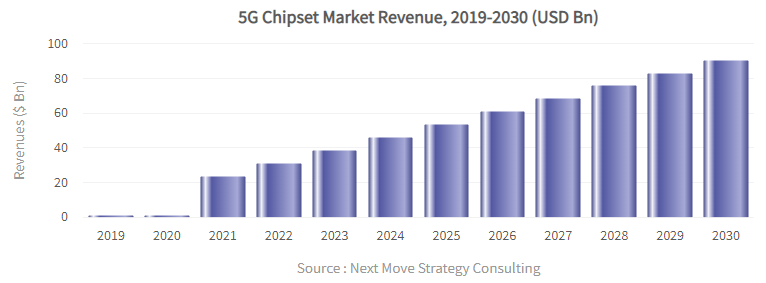The diagram below illustrates how the integration of 5G chipsets into vehicles promises to change the way people drive and interact with cars. 5G chipsets will bring high-speed connectivity and low latency to vehicles, enabling many new features and functions that were not possible before.

Enhanced connectivity
Enhanced connectivity is one of the most important ways 5G chipsets will change the automotive industry. With 5G technology, vehicles can connect to the internet at unprecedented speeds, enabling seamless communication between cars, infrastructure such as traffic lights and road signs, and other devices. This will usher in a new era of smart cars that can communicate with each other and their surroundings in real time, improving safety, traffic flow and efficiency.
In February 2023, Qualcomm announced that the latest addition to its growing portfolio of connected car technologies is its Snapdragon Auto 5G Modem-RF Gen 2. This is Qualcomm's most advanced automotive modem-RF, with a network capacity of 200 MHz, enabling it to provide reliable and low-latency connections. This is critical to ensuring a safe, smart and immersive riding experience.
5G chipsets boost autonomy
5G technology enhances the autonomous capabilities of vehicles. With ultra-low latency, vehicles can receive and process information faster, enabling them to make faster and more efficient decisions. This will allow more advanced autonomous systems to respond to changing traffic patterns, road conditions and unexpected obstacles more accurately than before. This will further help the automotive industry develop advanced safety features that can prevent such accidents from happening.
In January 2023, Quectel, the world's leading supplier of wireless communication modules and solutions, launched a new 5G NR module for the automotive field. Branded as the AG59x series, the new modules offer a wide range of enhanced features including direct communications, improved location services, high-performance multi-core applications processors, multi-gigabit cellular connectivity and enhanced security. All these features make it an ideal solution for autonomous driving.
Enhanced User Experience
5G technology will also significantly improve the user experience in vehicles. With the improved connectivity and bandwidth of 5G chipsets, passengers will be able to enjoy high-speed internet connections for streaming and real-time navigation services. This will enable new in-car entertainment options. Additionally, it will offer an advanced navigation system that can provide real-time traffic updates, alternative route suggestions and personalized recommendations.
In April 2022, BYD, one of the largest electric vehicle (EV) manufacturers, launched its flagship EV series called Han EV. It comes with a 5G chipset that brings fast data connections, allowing users to stay connected, stream HD videos, or play games online.
Improve vehicle maintenance
5G technology will also improve vehicle maintenance by enabling real-time remote monitoring and diagnosis of vehicles. With data streaming in real time from sensors and other components, automakers can detect potential problems before they become major problems. This allows for proactive maintenance, reducing the likelihood of unexpected failures and minimizing the risk of accidents. By accurately predicting maintenance needs, manufacturers can efficiently plan maintenance schedules, minimize downtime and reduce repair costs. Remote monitoring and diagnostics significantly improves vehicle maintenance, benefiting both vehicle manufacturers and vehicle owners.
The integration of 5G technology in vehicles presents several challenges that the industry is actively working to address. The rollout of 5G infrastructure is one of the biggest challenges. Adoption of 5G-enabled vehicles requires a reliable and widespread 5G network, which is not yet available in all regions. Governments and private organizations are investing in 5G infrastructure to ensure it is available in more areas.
Another challenge is the increased security risk. As 5G-enabled vehicles become more connected and share more data, so does the risk of cyberattacks. Hackers may attempt to gain access to vehicle systems, compromising the safety of the driver. To address this challenge, manufacturers are implementing advanced security measures, such as encryption and multi-factor authentication, to keep vehicle systems safe. They are also developing over-the-air software updates that can quickly address any security holes.
Cost is another challenge manufacturers face when integrating 5G technology into vehicles. The integration of such advanced technologies requires significant investment, which can increase the cost of the vehicle. However, as the technology became more mainstream, manufacturers took advantage of economies of scale to keep costs down. Vendors are also exploring new business models, such as subscription-based services, to make 5G-enabled vehicles more accessible to consumers. Together, ensuring they provide consumers with a seamless and safe driving experience, the industry is actively addressing the challenges associated with 5G-enabled vehicles.
Conclusion
With the integration of 5G chipsets, vehicles are expected to become safer, smarter and more efficient, paving the way for a new era of transportation. Despite the challenges of adopting 5G-enabled vehicles, the industry is actively working to overcome them.
Looking ahead to the future of the automotive industry, it's clear that 5G technology will play a vital role in influencing the way people drive and interact with vehicles. With real-time data streaming, monitoring, remote diagnostics, and improved connectivity, 5G technology will not only pave the way for future autonomous driving, but also improve the driving experience.
If interested, please feel free to contact us via BOM!



























